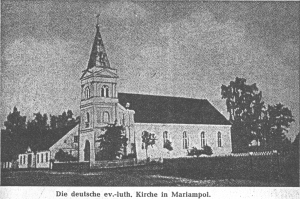The church in Mariampol started in 1800 at the same time that the German craftsmen began to move into this area. The German influence was evident here, and Protestant communities were soon organized. Logically, a Lutheran church followed. A pastor from Suwalki came once in a while to Mariampol. People listened to the German Lutheran beliefs, and soon that influence resulted in organizing a congregation. (1)
In the first decade of the 21st century a slightly different history is distributed by the Marijampole (the Lithuanian spelling) Evangelical Lutheran Congregation.
1819 is the starting year of Marijampole Evangelical Lutheran Congregation when local Evangelics applied for permission to establish a congregation and build a church. The Warsaw commission complied with the request and it was decided to allot a storehouse that had been built for a military regiment in 1804 or 1805 till the new church was built. (2)
Author’s Note: Note the inconsistency of 1819 as the starting date. This report also varies in other details about the history of the congregation that are not included here.
The Evangelics paid 20 gold coins per year. There were several attempts made in order to have the land and the storehouse as a present (i. e. gift), and at last Czar Alexander I signed the papers. (3)
The German Evangelical Lutheran Church in Mariampol (4)

“In 1835 Karolis Kaminskis made a project of the new church….The construction started in 1835 but lasted until 1841. The church was well seen from all sides and it became an important accent of the northern part of the town.” (5)
The German Evangelical Lutheran Church in Mariampol. “In 1835 Karolis Kaminskis
made a project of the new church….The construction started in 1835 but lasted until 1841. The church was well seen from all sides and it became an important accent of the northern part of the town.”
By 1831 the Mariampol Germans had their own pastor, Carl Heinrich Lange. He served the church with pastoral dignity. In 1854 the first German school was established. The school was the most influential German school in Lithuania. While their beliefs were German, the school was under Polish administration and later Russian authority. Instruction in the Russian language was required, and the students could only talk German two hours a week. There were 80 to 100 students. (6) After 1918 when Lithuania was independent, there were two teachers in the school and between 70 and 80 children. A few years later the enrollment dropped. (7)
Some Statistics
• In 1842 there were 2,997 inhabitants in Mariampol, and 233 were Evangelics.
• In 1844 there were 199 Evangelics.
• In 1851 there were 157 people (from 25 families) of the German nationality.
• During the tenure of the Reverend Carl Julius Pasternaci (1874 to 1894) the number of Lutherans reached 3,099. Now three filials (daughter congregations) of Kalvaria (to the south), Seirijai (to the southeast) and Vilkaviskis (to the northwest) belonged to Marijampole Evangelical Lutheran Congregation. (8)
In the Mariampol church there were the following pastors: 1831 to 1849 Karl Heinrich Lange; 1849 to 1872 Superintendent David Bergmann; 1872 to 1874 Reverend Roethke; 1874 to 1892 Carl Julius Pasternaci; and 1894 to 1941 Ernst Alexander Eichelberger. The reader may note that these were the same pastors in the Wylkowiszki parish. (9)
Their website is
1 Jaekel, Bilder aus der Geschichte des evangelischen Deutschtums in Litauen, 81.
2Some Facts from the History of Marijampole Evangelical Lutheran Congregation. Handout from the Marijampole Evangelical Lutheran Congregation, received July 2013 , 1.
3 Some Facts from the History of Marijampole Evangelical Lutheran Congregation, 1.
4 Jaekel, Bilder aus der Geschichte des evangelischen Deutschtums in Litauen, 83.
5 Some Facts from the History of Marijampole Evangelical Lutheran Congregation, 1.
6 Jaekel, Bilder aus der Geschichte des evangelischen Deutschtums in Litauen, 82.
7 Jaekel, Bilder aus der Geschichte des evangelischen Deutschtums in Litauen, 83.
8 Some Facts from the History of Marijampole Evangelical Lutheran Congregation, 1-2.
9 Jaekel, Bilder aus der Geschichte des evangelischen Deutschtums in Litauen, 83.
